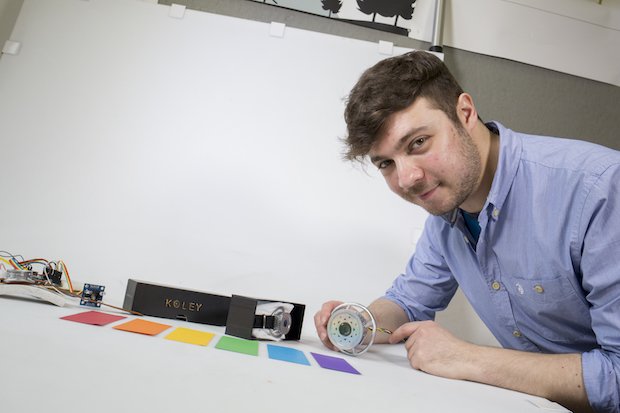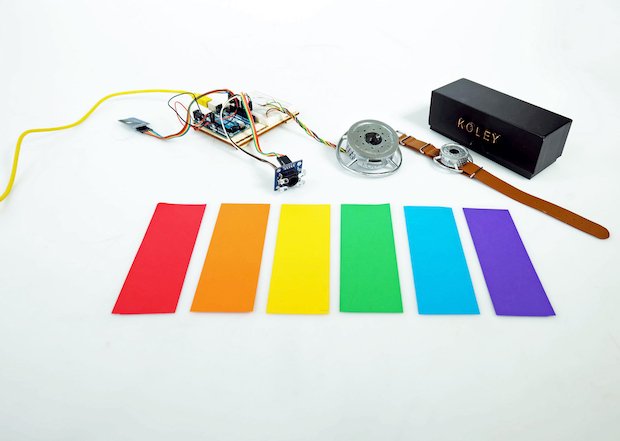The device is set to help blind people identify colours and shades, and act as a contactless payment method.
A student from Nottingham Trent University has leveraged 3D technology to design a wearable device that can help the visually impaired identify colours.
Andrew Cowen, a 23-year-old Product Design student, was inspired by his grandmother who was registered blind for 40 years before her recent passing. The device, named KOLEY, is worn on the wrist and can identify the colour of an item when pointed in its direction. It transmits this information by either describing it aloud, or through an optional earpiece.
The device was initially conceived as a solution for blind shoppers, but Cowen believes it could also be utilised to tell the difference in fruit ripeness, recognise medication box colours and identify paints for blind artists, among other things.
Cowen modelled up the device using SOLIDWORKS software, creating the shapes and details of the wearable part. As he developed the design, he used the university’s Stratasys uPrint SE Plus to print several models in ABS plastic, removing the supports in the acid bath. When the design was finalised, the device was printed on a 3D Systems Projet 3500 HD Max in UV cured resin. Since this was a high definition print, and didn’t show any layering, Cowen was able to take this to be spray painted for a metallic finish.
“Ideally, I would have printed this in Stainless Steel 316 at Frazer Nash but the item would be about £350 and so that’s why I painted up a model to show my prototype,” Cowen told TCT. “I’ve also 3D HD printed a bigger version to scale of my wearable which is a functioning prototype as it fits in a colour sensor attached to a programmable Arduino Circuit Board and other components such as a memory card and a speaker.”
The device uses photodiode’s which can detect red, green and blue colours, feeding information into a processor which matches it to a pre-programmed code that identifies and communicates the colour back to the wearer. This technology can also detect shades of colour, which is how Cowen is sure it will be able to inform blind people how ripe fruit and vegetables are. Additionally, Cowen’s working prototype can be used as a contactless payment device, thanks to a unique near-field communication (NFC) chip.
Designed as part of Cowen’s final year project, he consulted a group of visually impaired people at MySight, a charity for the blind based in Nottinghamshire.
“The visually impaired often have bland wardrobes, and don’t have the opportunity to express themselves through the colour of their clothes.” Said Cowen. “My grandma often wore bright clothes as they were more cheerful, but found it difficult to match colours correctly. She inspired me to use my degree research to design a useful solution to help her and others who have problems with their vision.
“I wanted to create something that has future potential to aid all visually impaired people, with further development I hope the device will be able to read text making daily life easier and giving greater independence.”
After graduating from university, Cowen will seek investment and support to scale down his larger device, so it is of similar size to a wristwatch. There are also future plans to make the device induction chargeable, removing the need for potential struggle with plug sockets.
“Andrew’s product has the potential to make a big impact on the lives of the visually impaired,” said James Dale, Principle Lecturer of Product Design at Nottingham Trent University. “Using his own research and support from the course, he has seen the product through from design to prototyping, and with further development his design has a wealth of new possibilities.”
Andre Cowen’s wearable device will go on display at Nottingham Trent University’s 2017 Degree Show from 3rd June to 10th June at the City site.



